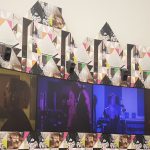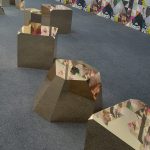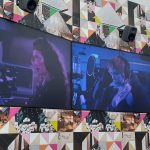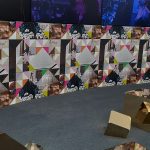London calling | chapter 4
Sonia Boyce
Feeling Her Way
ITA (English below)
Alla 59esima edizione della Biennale di Venezia, l’artista britannica Sonia Boyce presenta Feeling Her Way, una installazione basata sulle performance vocali di cinque musiciste nere e sul contributo delle donne di colore alla musica e alla cultura transnazionale.
Con Feeling Her Way, Sonia Boyce (1962), prima donna nera a rappresentare la Gran Bretagna alla Biennale di Venezia, si interroga (e interroga), sull’idea di libertà, su cosa significhi essere liberi e su come le costrizioni o le aspettative degli altri possano influenzare e contenere il modo di esprimersi di una persona.
Che tipo di condizioni vi servono per sentirvi liberi di esprimere voi stessi
quando non siete limitati da ciò che gli altri pensano che dovreste o potreste essere?
Cosa significa sentirsi liberi…e come potreste comportarvi?
La collaborazione con altri artisti, il coinvolgimento del pubblico, e il risalto dell’improvvisazione durante l’atto creativo, sono alcuni dei metodi centrali della ricerca dell’artista britannica, interessata al: “modo in cui rispondiamo…come impariamo, ascoltiamo, come assistiamo allo sviluppo dei rapporti con gli altri”.
Uno degli elementi base di Feeling Her Way è la fiducia, la quale si manifesta su vari livelli, attraverso la collaborazione tra l’artista e le cantanti e tra le musiciste stesse; l’invito all’ascolto della Boyce è anche e soprattutto un invito al rispetto reciproco, alla fiducia verso il prossimo, elemento essenziale non solo per il momento creativo e l’improvvisazione, ma anche per il momento successivo, quello dell’ascolto e della ricezione del messaggio. Rispondendo (in parte) agli interrogativi sopracitati dell’artista, la fiducia è senz’altro tra le condizioni necessarie per libertà di espressione, sia in ambito creativo/artistico che in un contesto altro.
L’installazione video si sviluppa attraverso la sala centrale e quelle laterali del padiglione britannico, le cui pareti sono ricoperte da una plateale cornice, composta da una vistosa carta da parati che riproduce forme geometriche accompagnate da immagini riprese durante la registrazione delle performance; degli oggetti volumetrici dorati fungono anche da sedili per i visitatori. Mentre la carta da parati riprende un motivo ricorrente della ricerca dell’artista, gli oggetti fanno riferimento alla pirite, minerale che proprio per il suo colore dorato, è stato chiamato “l’oro degli stolti”: qui l’artista, riprendendo un’espressione che ha avuto origine in ambito coloniale, cerca di ribadire il distinguo tra le aspettative (e i giudizi verso ciò che è altro) e la realtà.
Nella sala centrale, quattro delle cinque musiciste sono riprese individualmente su quattro video con filtro colore, durante la session agli Abbey Road Studios. La compositrice Errolyn Wallen OBE conduce le altre cantanti (Jaqui Dankworth MBE, Poppy Ajudha e Tanita Tikaram) che rispondono alle direttive ora con umorismo, ora con disagio, ora con sorpresa per qualche acuto inaspettato: il tutto è ripreso senza filtri, con gli errori, le pause e le imperfezioni tecniche a creare un ambiente gioviale e libero da costrizioni.
Nelle sale laterali, le cantanti sono presentate singolarmente mentre si esibiscono in pezzi acustici e improvvisazioni vocali: chi canta a cappella, chi si esibisce in virtuose sperimentazioni con la propria voce, chi risponde vocalmente e cerca di emulare suoni di strumenti musicali. In ogni punto del padiglione è possibile sentire i suoni e le voci delle sale adiacenti, creando un affascinante legame, non sempre armonico, che stimola i sensi del visitatore, come ad esempio accade nella sala 3, Sofia and Jaqui: qui, le due cantanti si esibiscono in una sorta di duetto preregistrato (Sofia Jernberg non ha potuto partecipare alla session agli Abbey Road Studios per motivi legati alle regole internazionali sulla quarantena), in cui la Jenberg si presta a sfidare le sue capacità canore toccando acuti altissimi mentre la voce della Dankworth imita a ripetizione il suono di una campana da chiesa.
Oltre alle video installazioni, l’artista assembla lungo un’ampia parete della sala posteriore (intitolata Devotional) una raccolta di memorabilia che riguardano le stesse musiciste di Feeling Her Way e non solo. I memorabilia (cd, copertine di album, cassette, fotografie), sono collocati all’interno e/o circondati da oggetti dorati che riprendono le forme geometriche della pirite (peculiarmente, ma non casualmente, alcuni degli oggetti riportano le etichette con il prezzo scontato).
Per contestualizzare il significato di Devotional, si può fare riferimento alle motivazioni espresse per l’assegnazione del Leone d’Oro all’artista britannica per la miglior partecipazione nazionale alla 59. Biennale di Venezia, dalla giuria, la quale ha dichiarato che:
Sonia Boyce propone un’altra lettura delle storie attraverso il suono.
Lavorando in collaborazione con altre donne nere, svela una moltitudine di storie rimaste inascoltate.
La raccolta e l’esposizione di memorabilia, difatti, riprende e accresce Devotional Collection, un archivio ideato nel 1999 con l’intento di documentare l’apporto che le musiciste britanniche di colore hanno avuto (e che continuano ad avere) sulla cultura transnazionale. Tale progetto, come altri ideati da Sonia Boyce, come ad esempio la recente mostra alla Tate Modern, Life Between Islands, muove da una necessità di documentare non solo l’apporto delle musiciste britanniche nere ma anche a marcare e (ri)scoprire la loro identità e le loro storie, come “forma di costruzione della conoscenza collettiva”.
* * *
ENG
At the 59th edition of the Venice Biennale, the British artist Sonia Boyce presents Feeling Her Way, an installation based on the vocal performances of five black musicians and the contribution of women of color to transnational music and culture.
With Feeling Her Way, Sonia Boyce (1962), the first black woman to represent Great Britain at the Venice Biennale, investigates the idea of freedom, what it means to be free and how constraints or expectations from others can influence and contain a person’s way of expressing themselves.
What kind of conditions do you need to feel free to express yourself
when you are not limited by what others think you should or could be?
What does it mean to feel free… and how could you behave?
The collaboration with other artists, the involvement of the public, and the emphasis of improvisation during the creative act, are some of the central methods of the British artist’s research, interested in: “how we respond … how we learn, listen, how we witness the development of relationships with others “.
Trust is one of the basic elements of Feeling Her Way, which manifests itself on various levels, such as through the collaboration between the artist and the singers and between the musicians themselves; Boyce’s invitation to listen is also and above all an invitation to mutual respect, to the trust in others, an essential element not only for the creative moment and improvisation, but also for the next moment, that of listening and receiving the message. Responding (in part) to the artist’s aforementioned questions, trust is undoubtedly one of the necessary conditions for freedom of expression, both in the creative / artistic sphere and in another context.
The video installation develops through the central hall and the side rooms of the British pavilion, whose walls are covered with a dramatic and gaudy wallpaper that reproduces geometric patterns accompanied by images taken during the recording of the performances; volumetric gilded objects also serve as seats for visitors. While the wallpaper takes up a recurring motif of the artist’s research, the objects refer to pyrite, a mineral that, precisely because of its golden color, has been called “the gold of fools”: here the artist, taking up an expression that originated in the colonial context, tries to reiterate the distinction between expectations (and judgments towards what is other) and reality.
In the central hall, four of the five musicians are shot individually on four colour-filtered videos, during the session at Abbey Road Studios. The composer Errolyn Wallen OBE leads the other singers (Jaqui Dankworth MBE, Poppy Ajudha and Tanita Tikaram) who respond to the directives now with humor, now with discomfort, now with surprise for some unexpected high note: everything is taken up again without filters, with the errors, the breaks and the technical imperfections to create a jovial environment free from constraints.
In the side rooms, the singers are presented individually while they perform acoustic pieces and vocal improvisations: those who sing a cappella, those who perform virtuous experiments with their own voice, those who respond vocally and try to emulate the sounds of musical instruments. In any point of the pavillion it is possible to hear the sounds and voices of the adjacent rooms, creating a fascinating bond, not always harmonious, which stimulates the visitor’s senses, as happens for example in room 3, Sofia and Jaqui: here, the two singers perform in a sort of pre-recorded duet (Sofia Jernberg was unable to attend the session at Abbey Road Studios for reasons related to international quarantine rules), in which Jenberg lends herself to challenge her singing skills by touching very high treble while Dankworth’s voice imitates a repeat the sound of a church bell.
In addition to the video installations, the artist assembles along a large wall in the rear room (entitled Devotional) a collection of memorabilia concerning the same musicians of Feeling Her Way and others. The memorabilia (CDs, album covers, cassettes, photographs), are placed inside and / or surrounded by golden objects that reflect the geometric shapes of pyrite (peculiarly, but not coincidentally, some of the objects bear the labels with the discounted price).
To contextualize the meaning of Devotional, reference can be made to the reasons expressed for the awarding of the Golden Lion to the British artist for the best national participation in the 59th Venice Biennale, by the jury, which stated that:
Sonia Boyce proposes another reading of stories through sound.
In working collaboratively with other black women, she unpacks a plenitude of silenced stories.
The collection and exhibition of memorabilia, in fact, takes up and increases the Devotional Collection, an archive created in 1999 with the aim of documenting the contribution that British musicians of color have had (andcontinue to have) on transnational culture. This project, like others conceived by Sonia Boyce, such as the recent exhibition at the Tate Modern, Life Between Islands, moves from a need to document not only the contribution of black British female musicians but also to mark and (re) discover their identities and their stories, as a “form of construction of collective knowledge”.









